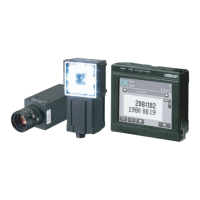Controlling Operation and Outputting Data with EtherNet/IP Communications
88
FQ2-S/CH User’s Manual
for Communications Settings
3-1
Controlling Operation and Outputting Data with EtherNet/IP Communications
FQ2-S3 FQ2-S4
Introduction to EtherNet/IP
EtherNet/IP is an industrial multi-vendor network that uses Ethernet.
The EtherNet/IP specifications are open standards managed by the ODVA (Open DeviceNet Vendor
Association). EtherNet/IP is used by a wide range of industrial devices.
Because EtherNet/IP uses standard Ethernet technology, various general-purpose Ethernet devices can be
used in the network.
EtherNet/IP has mainly the following features.
● High-speed, High-capacity Data Exchange through Tag Data Links
The EtherNet/IP protocol supports implicit communications, which allows cyclic communications called tag
data links with EtherNet/IP devices.
● Tag Data Links at Specified Communications Cycle for Each Application Regardless of the Number of Nodes
Tag data links (cyclic communications) operate at the cyclic period that is specified for each application,
regardless of the number of nodes. Data is exchanged over the network at the refresh cycle that is set for each
connection. The communications refresh cycle will not increase even if the number of nodes is increased, i.e.,
the concurrency of the connection’s data is maintained.
Because the refresh cycle can be set for each connection, each application can communicate at its ideal
refresh cycle. For example, interprocess interlocks can be transferred at high speed, while the production
commands and the status monitor information are transferred at low speed.
On a network to which many devices are connected, performance may drop (e.g., responses may be delayed or pack-
ets lost) or communications errors may occur when there is temporarily high traffic on the network. Test the operation
under actual conditions before you start actual operation of the system.
FQ2-S_CH_comm.book 88 ページ 2014年6月26日 木曜日 午前11時47分

